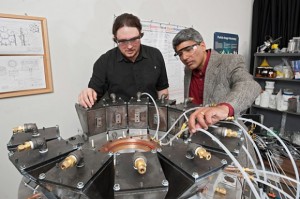Researchers at Wake Forest University are working on a cool nanotech application – developing a fabric-like material that generates electricity from body heat. It’ll be neat to see if something like this reaches the mainstream market. Read the full paper here, or check out the CNN video below.
Catalytic-driven hydrogen generation
I’m seeing more and more reports of studies involving the use of catalysts to generate hydrogen. This is a fascinating development, so I’ll be posting more of those here (follow this link for a description of the work CalTech is doing on this). The basic premise is to heat water to a point where an added catalysts splits the water molecules into their oxygen and hydrogen components, the hydrogen is then used as fuel. More importantly, the hydrogen can then be stored for later use. For example, imagine a solar thermal collector used to generate the heat to drive this reaction, with excess hydrogen being stored for use during night. It’s a sort of hydrogen battery, if you will.
This research is still in the laboratory stage, but is an interesting path to sustainable energy solutions which address the energy storage concerns.
NREL energy analysis
The National Renewable Energy Laboratory (NREL) has published a study that looks at the extent to which renewable energy can meet the demands of this country over the next few decades. What they found was that existing technologies, that are commercially available today, are more than sufficient to provide 80% of total electricity generation by 2050.
No one wants to pay higher prices for electricity to fund this, but the reality is that the course we’re on is unsustainable and change is inevitable. The sooner we begin that change, the smoother it will go. So what are we waiting for?
Advances in Solar Panel Technology
Solar energy technology is advancing fast enough that I’ve decide to lump together several updates into single posts now and then.
To start with, the Frauenhofer Institute has showed off some highly flexible solar panels, placing them on a ski helmet. This may not sound like a big deal, flexible panels have been around for a while, right? Well, not really. Typically, when you see a flexible panel, it can only bend in one direction – around a cylinder, for example. This new technology allows the panel to conform to compound surfaces, like a sphere or, in this case, a ski helmet. For now, testing this on ski helmets is a good, extreme use environment (the solar cells become more efficient with cold, but batteries become less efficient). Just about ever helmet design could benefit the user with this – motorcyclists, construction workers, bicyclists, you name it. The first product, a ski helmet, is targeted for sale at the end of 2012.
Solar cell comparisons invariably come down to one key metric, the efficiency. Going along with this is measuring reflectance, or how much solar energy is reflected and thus unable to be converted into electric energy. Scientists at Natcore Technology have set a new record for this, producing wafers that absorb an incredible 99.7%! This promises to increase solar panel efficiency, which in turn will lower cost and increase adoption of solar energy worldwide.
There are two main types of solar energy devices on the market today – photovoltaic panels that covert visible wavelengths into electric power, and solar thermal that takes the abundant infrared radiation emitted by the sun and uses that heat energy to do the same (via turbines or other methods, or just using the heat directly to heat a house or water heater). Now, Naked Energy has designed a hybrid solar energy system which has solar panels to make electricity, but also pumps water through the tubes to make that heat available for other energy uses (heating a house being the most feasible). It’s not a utility-scale sort of system, but great for home or business users.
Self-sustaining solar-powered Hydrogen generator
 Engineers at the University of Delaware have developed a prototype hydrogen generator that has the potential to revolutionize solar energy production. Solar thermal energy is used to vaporize zinc oxide powder. This gas is then reacted with water to produce hydrogen gas and zinc powder (which can then be fed back into the system). The shortcoming of any solar energy system is energy storage, and a system that produces hydrogen gas solves that as the gas can be stored for later conversion to electrical power in a fuel cell.
Engineers at the University of Delaware have developed a prototype hydrogen generator that has the potential to revolutionize solar energy production. Solar thermal energy is used to vaporize zinc oxide powder. This gas is then reacted with water to produce hydrogen gas and zinc powder (which can then be fed back into the system). The shortcoming of any solar energy system is energy storage, and a system that produces hydrogen gas solves that as the gas can be stored for later conversion to electrical power in a fuel cell.
The system requires further testing but it’s off to a promising start! Read more at Physorg.
